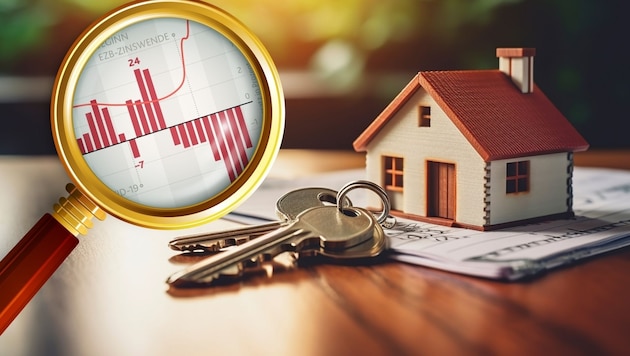Apartments and houses
Where real estate prices are falling in Austria
Prices for apartments and houses are beginning to fall. The sharpest declines were recorded in Upper Austria, Vienna and Lower Austria. Nevertheless, Austrian consumers cannot afford new housing - purchases have fallen by more than half.
Years of rising residential property prices have come to an end. According to calculations by Statistics Austria, houses and apartments in Austria cost an average of 2.6 percent less in 2023. Prices for existing housing were 3.7 percent lower than in the previous year, but there was only a slight decrease of 0.1 percent for newly built apartments and houses. According to experts, the sharpest declines were in Upper Austria, Vienna and Lower Austria.
In comparison: in 2021, there was an average year-on-year increase of 13.1% for existing apartments and houses, while in 2022 the increase was 11.6%. Last year, the price curve then pointed downwards: Existing apartments were down 4.3 percent and houses were down 3.1 percent.
Large regional differences
Newly constructed properties, on the other hand, are very stable in price. However, there were major regional differences in newly built apartments. In Vienna, prices fell by 3.7% compared to 2022, and by 1.7% in the rest of eastern Austria (excluding Vienna). In contrast, prices rose by 6.9% in western Austria and by 4.2% in southern Austria. The average price of new homes in Austria fell by 0.9 percent.
A similar picture emerges with regard to house prices (new and existing properties). According to Statistics Austria, Vienna reported the most striking decline at minus 6.7 percent, followed by Lower Austria with minus 4.9 percent and Upper Austria with minus 4.4 percent. In Burgenland and Vorarlberg, house prices fell by 2.2 percent and 1.3 percent respectively. There were price increases in Styria (plus 0.7 percent), Tyrol (plus 1.3 percent) and Salzburg (plus 1.4 percent). The biggest increase was in Carinthia (plus 2.1 percent).
Despite the turnaround, many domestic customers were unable to afford real estate. The number of property purchases fell by 28.2% in 2023 compared to the previous year. There was a slump in new residential properties in particular, where purchases fell by more than half (minus 51.6%). The number of transactions for existing residential properties fell by 20.7 percent.
Austria reacts more strongly than other EU countries
In a European comparison, the Austrian housing market reacted somewhat more strongly to the new market environment than the eurozone (-1.1%) and the European Union as a whole (-0.4%) with an average price decline of 2.8% in the first three quarters of 2023 (the fourth quarter will not be published internationally until April 2024) compared to 2022. Germany recorded the largest price decline in the EU during this period at -8.9 %.












Kommentare
Willkommen in unserer Community! Eingehende Beiträge werden geprüft und anschließend veröffentlicht. Bitte achten Sie auf Einhaltung unserer Netiquette und AGB. Für ausführliche Diskussionen steht Ihnen ebenso das krone.at-Forum zur Verfügung. Hier können Sie das Community-Team via unserer Melde- und Abhilfestelle kontaktieren.
User-Beiträge geben nicht notwendigerweise die Meinung des Betreibers/der Redaktion bzw. von Krone Multimedia (KMM) wieder. In diesem Sinne distanziert sich die Redaktion/der Betreiber von den Inhalten in diesem Diskussionsforum. KMM behält sich insbesondere vor, gegen geltendes Recht verstoßende, den guten Sitten oder der Netiquette widersprechende bzw. dem Ansehen von KMM zuwiderlaufende Beiträge zu löschen, diesbezüglichen Schadenersatz gegenüber dem betreffenden User geltend zu machen, die Nutzer-Daten zu Zwecken der Rechtsverfolgung zu verwenden und strafrechtlich relevante Beiträge zur Anzeige zu bringen (siehe auch AGB). Hier können Sie das Community-Team via unserer Melde- und Abhilfestelle kontaktieren.